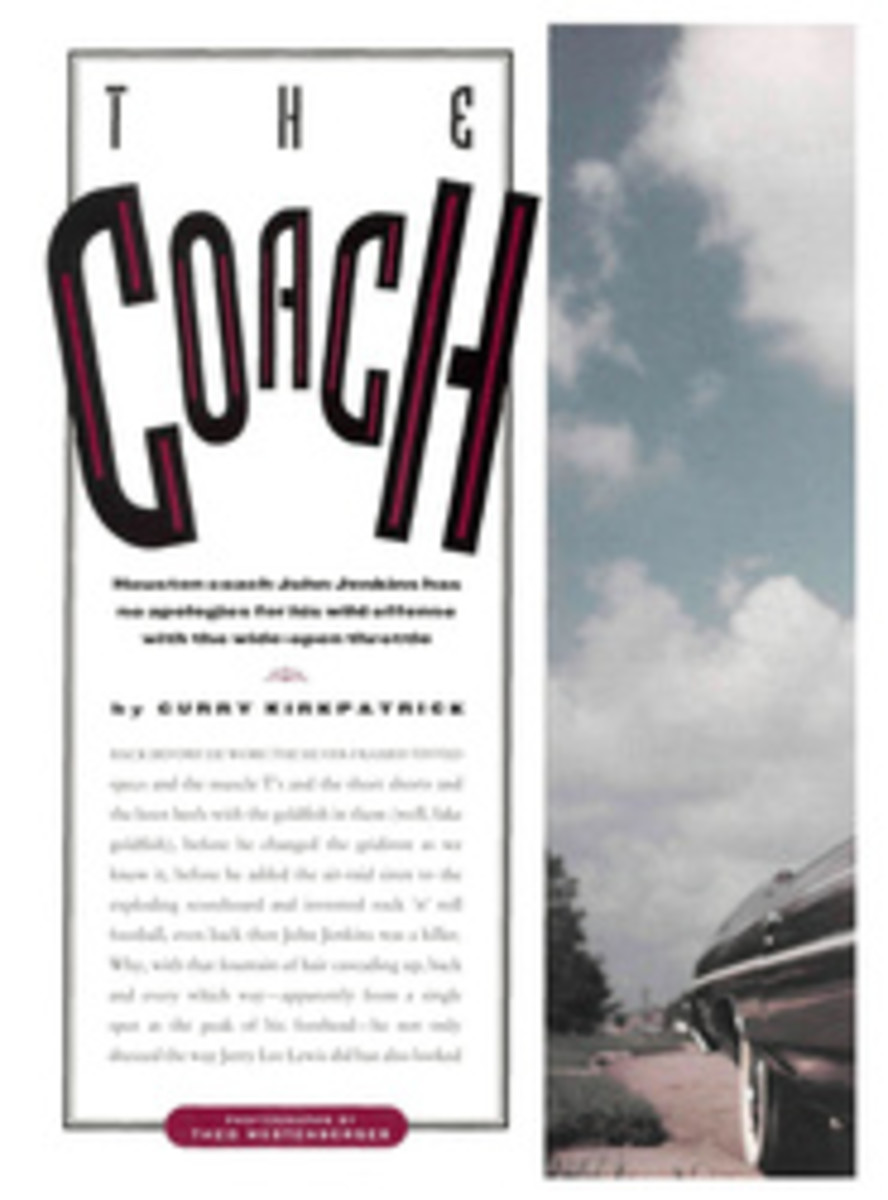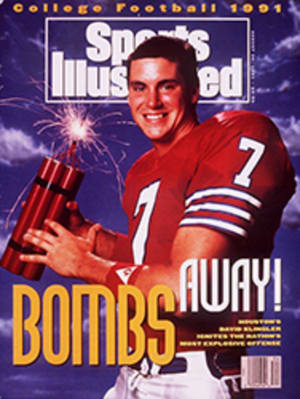
Present at the Re-creation
I don't want you to think it's always like this," says sportscaster Bob Robertson. Aside from the rain that's falling at Sky Sox Stadium in Colorado Springs, tonight's broadcast of a Pacific Coast League game between the Tacoma Tigers and the Sky Sox is hampered by a technical difficulty. The man on the phone in the stadium press box doesn't quite understand what's going on.
"I need the batting order," Robertson tells him patiently. "I'm doing the broadcast out of what you give me. Russ McGinnis [the Tiger catcher] is leading off? Are you sure?"
What is there to be sure of? From a radio studio in Tacoma, Wash., a thousand miles away from the field of play, Robertson will describe the action at the Tiger-Sky Sox game using notes passed to him by an assistant, on this occasion, his 21-year-old son, John, who fills in a scorecard from what he is being told over the telephone.
"We call you about every half hour," Bob Robertson explains to the press-box observer. "We need pitching changes, weather changes, and we need to keep track of it at this end. Do you know who the umpires are? Wait a minute. We have too many rightfielders and not enough infielders."
It usually takes only 10 minutes to gather the preliminary game information and about eight calls over the course of a game to keep the scorecard up-to-date. Most of Robertson's contacts around the league are familiar with the routine, so an update, covering one to three innings, usually lasts no longer than a three-minute call.
On five- by eight-inch sheets of paper, each covering a half-inning, John writes down what every batter does, using notes that are somewhat expanded from scorecard shorthand. His "/sc" becomes "singled to center." From this meager information the elder Robertson creates a scenario for the at bat, filling in the background of the hitter and the pitcher, describing the scenery and making up each pitch.
Had he been around 50 years ago, when announcers routinely re-created ball games from pitch-by-pitch reports coming in by telegraph, Robertson's batter-by-batter approach would have been considered unusual. But he's not bothered by the relative dearth of information he must work from. Robertson has been doing re-creations since 1949, and he is believed to be the last broadcaster in the U.S. regularly practicing the art.
Robertson turned to broadcasting following one season as an outfielder-first baseman for the Salem (Ore.) Senators of the Class B Western International League. He mastered the basics of re-creating games while he covered the Wenatchee (Wash.) Chiefs of the WIL in 1949-50, and over the subsequent decades the skill has served him well both in baseball—he has covered the Tacoma Tigers since 1985—and in other sports. He is also the voice of football and basketball at Washington State, where travel schedules sometimes require him to re-create games in those sports.
When the Tigers are at home, the 62-year-old Robertson broadcasts from a booth overlooking the playing field at 8,500-seat Cheney Stadium. But when they are on the road, his "view" from the radio studio of station KLAY, which currently broadcasts Tacoma's games, or from KTAC, which had previously carried the Tigers, has never seemed impaired by mere distance. "Of course, there's no guarantee that what they're giving me is right," Robertson says of the telephone reports he gets from observers. And what of the sliders, curves and fast-balls that he calls as the game progresses? "It's pretty much folderol," he admits.
Robertson also can employ an elaborate variety of sound effects to add verisimilitude to his calls, but for this 1990 Colorado Springs game he has reduced the audio backgrounds to the basics. "No jet planes tonight," he says, having used them, maybe more than was needed, in a four-game series with the Phoenix Firebirds, whose Municipal Stadium is under the flight path for planes at Phoenix's airport.
Meanwhile, in Colorado Springs, the rain has stopped, and in Tacoma the younger Robertson has begun filling out his yellow sheets with data. Unfortunately, the beginning of the game catches engineer Robert Hoffman eating his dinner.
"We got a start," says Bob Robertson; then, acknowledging his engineer's appetite, he adds, "When Robert finishes eating, we're going to start the game call." After a warmup show, done from media guides, player file cards, newspapers and Robertson's own notebook, the first pitch is delivered at 8:11 p.m. in Tacoma.
The broadcast runs about 40 minutes after the action described has actually taken place. While John gathers information on the progress of the game over the phone, his father slowly unfolds the drama. The count goes to 3-1 or 3-2 on nearly every hitter.
Robertson sits on a stool, facing a window that overlooks a shopping mall. There's not a whole lot to see, but, no matter, he rarely looks outside; most of the time his head is down as he pores over the yellow sheets. He knows the 10 PCL ballparks by heart. When there's a foul ball—created by him—Robertson will frequently take his listeners on a verbal tour of the stadium. But there are occasions when he has to describe players he has never seen. Not tonight, however.
"I think he's actually seeing this game," says John of his father's ability to re-create the action. And in truth, many times it seems that the scenes Robertson creates in his broadcast are more vivid, more real, than those reported by someone actually at the ballpark.
But let's be perfectly frank: It's Robertson's game, and he is not a man to make a big deal out of losing track of the count. "It's my count," he explains after the broadcast, dismissing any need to consult a ball-and-strike indicator.
The first half of the first inning between the Tigers and the Sky Sox ends at 8:28 p.m. Three runs on three hits and no errors fill 17 minutes.
John places a stack of coming half-innings before his father. Bob barely glances at them. "I try not to look too far ahead, because I don't want to know what's coming," he says.
Sky Sox Stadium is playing true to form this evening. The first two innings yield 12 runs. The furious scoring in Colorado Springs complicates John's transcribing job. But after the on-the-scene observer misses the distinction between a base hit and a fielder's choice, John doesn't even bother asking him how to score the action on a subsequent complicated rundown play. In any event, the chore of moving the runners along proceeds efficiently, thanks to some fancy footwork on the part of his father.
And then it happens. A mistake. On a single in the bottom of the third, Robertson drives in the men from second and third. But in the real world only the man on third has scored.
"Do they score a run later?" asks Bob between pitches, when his microphone is off. John shakes his head. Not so far. His father turns back to the mike.
The pace of the game picks up as fewer men reach base. But later, in Colorado Springs, another Sky Sox score allows Robertson to make the necessary correction. The score in Tacoma now agrees with that in Colorado Springs. So smoothly has it been done that no listener suspects how close the recreated game has come to extra innings. Tacoma wins by one run.
"A nail-biter right to the end," Robertson says on the air. An ironic reference to the re-creation process?
"Sometimes I slip up, but I'm not going to admit I'm here in the studio. Some people may think it's blatantly dishonest, but the idea is to get into the game, to see it as if you were there."
And there are times that Robertson does see the game better than if he were there. A night earlier, against Phoenix, Tiger third baseman Larry Arndt had cut himself reaching over the fence for a pop foul. The reporter on the scene made it sound as if Arndt had run into a chain saw. "Blood all over the place—you couldn't say that on the radio," says Robertson, citing the women and children in his radio audience. Instead, Robertson called a play in which Arndt reached for a foul out of play. Robertson also mentioned that the infielder might have caught his forearm on some wire—hardly the gruesome elbow-to-shoulder gash reported by the excited eyewitness.
The actual medical report? Cut on the forearm; 11 stitches.
"I had it better than he had," says Robertson, with a mixture of wonder and pride.
PHOTO
REX RYSTEDT
At Tiger home games, Robertson looks for player traits he will later "see" in his re-creations.
PHOTO
REX RYSTEDT
With scant information to go on, Robertson must rely on experience and imagination.
Doug Nufer is author of the "1990 Guide to Northwest Minor League Baseball."

